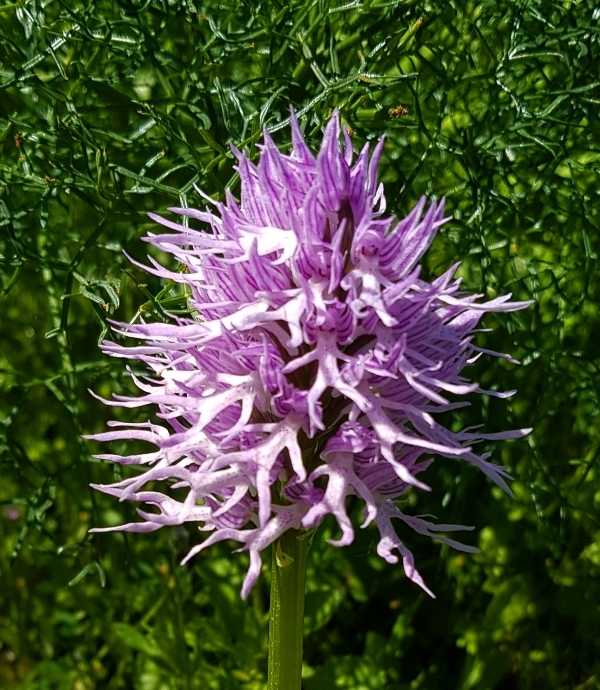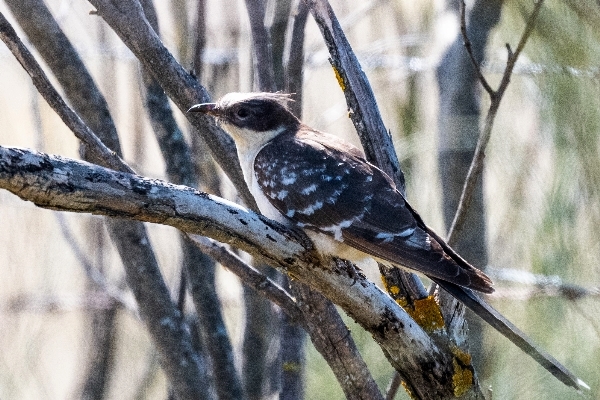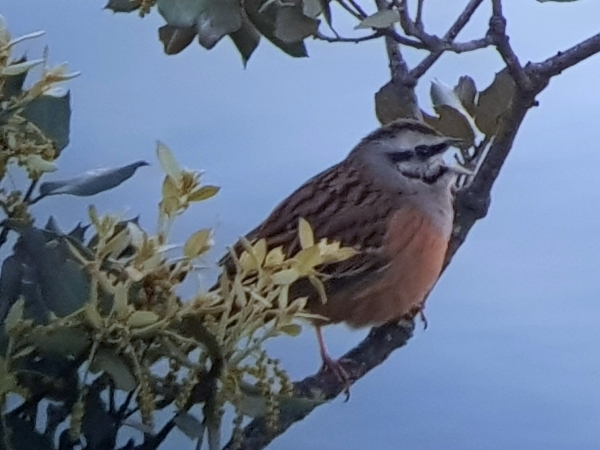Tours
- Overview/list of tour details
- SOMERSET LEVELS
- Colombia - Andean Endemics
- Sri Lanka
- Costa Rica
- Morocco
- Coto Donana and Extremadura
- Lesvos
- Lake Kerkini - N Greece
- Bulgaria
- Eastern Poland
- Extremadura & Sierra de Gredos
- Spanish Pyrenees
- Andalucia - Birds and Butterflies
- Spain - Autumn Migration I
- Isles of Scilly
- Dorset - Autumn Tour
- Gambia
- Day Tours - Spain
- Day Tours UK
EXTREMADURA SHORT SPRING BREAK FOR BIRDS AND ORCHIDS
APRIL 11th - 16th 2026
In Extremadura we stay just north of Trujillo which is a central position from where you will discover the delights of this unique area. Extremadura has vast areas of open grassland, steppe and hundreds of square miles of dehesa.
Dehesa is by far the most dominant feature of Extremadura. It is a multifunctional cultural landscape comprising of open woodland, combined with grazing pasture. The trees grown in dehesa are oak, some cork but mainly holm oak. This is home to Spain’s most iconic domesticated animal, the Ibérico pig, which wanders among the oaks feasting on the sweet acorns, giving the ham its unique flavour. Local breeds of Cattle, Sheep and goats also graze the land and fertilize the soil. Dehesa supports many species of birds, insects and mammals.

Naked-man Orchid (Orchis italica)
Extremadura is surrounded on three sides by mountains and provides perfect habitat for many endangered European species such as the Spanish Imperial Eagle, Great and Little Bustards, Black-bellied and Pin-tailed Sandgrouse. We may also encounter the Great Spotted Cuckoo, Bee-eater, Hoopoe, Roller, Golden Eagle, Bonelli's Eagle, Black Vulture, Black Stork and many larks, finches, pipits and buntings.

Itinerary in brief:
- Day 1 - Afternoon flight to Madrid Transfer to Extremadura Hotel
- Day 2 - Full day in Monfrague National Park
- Day 3 - Caséres & Santa Marta de Magasca steppe, Rio Almonte, Belen Plain
- Day 4 – a visit to Arrocampo Reserve, Jaraicejo Heathland and Rio Almonte.
- Day 5 - A visit to Merida, Alange and Embalse de Alange
- Day 6 – Mid-moring flight home.
A TYPICAL ITINERARY
DAY 2 - APRIL 12th
After a late afternoon arrival at Madrid on Day 1 and transfer to Extremadura, we make an early start from Madrid Airport today and set off for Extremadura making several stops along the way. Our first stop will be the large country park called El Pardo. This is a wonderful area of pine woods, open meadows, reed-finged pools and a river. Many species can be seen there. We shall search for Penduline Tit, Firecrest, Crested Tit, Cetti's Warbler, Common Nightingale, Bee-eater, Hoopoe, Short-toed Treecreeper.
In the reeds we may see Purple Swamphen and if we are lucky Little Bittern, Squacco Heron and maybe a species of Crake.
We may also see Black & Red Kites, White Storks, Booted & Short-toed Eagles, Spotless Starling, Corn Buntings and Spanish Sparrow, Vultures and possibly an Imperial Eagle. Many of these raptors will be seen along the way to Extremadura or during a coffee stop.
At lunchtime we arrive near a town called Almaraz where we visit the ‘Orchid Garden’ which will be our second stop! This unique area has a limestone outcrop which supports many orchid species seldom seen elsewhere in Extremadura. Naked-man Orchid (Orchis italica), Conical (Orchis conica), Champagne (Orchis champagneuxii), Mirror Ophrys (Ophrys ciliata), Woodcock (Ophrys scolopax), Yellow (Ophrys lutea),) and Tongue Orchids (Serapias species) may be seen. We shall also look Sawfly (Ophrys tenthredinifera), Giant Orchid (Barlia robertiana) and Dull (Sombre) Orchid (Ophrys fusca) in other areas during our stay.

Champagne Orchids with Naked-man Orchid in the background
DAY 3 – MONFRAGÜE NATIONAL PARK ALL DAY VISIT
Just a stone’s throw from our hotel lies Monfragüe National Park, Spain’s flagship nature reserve and a wonderful place to visit. We shall spend all day discovering the miradors, tracks and out-of-the way areas to discover the fantastic wildlife of this exquisite area.
Expect to see all three Vultures species and up to four Eagles, Kites, Kestrels, Peregrines, Sparrowhawks and Harriers, you will enjoy a raptor fest!! But its not all about raptors, the steep cliff faces are also home to Blue Rock Thrush, Rock Bunting, Black Redstarts, Crag Martins, House Martins and Red-rumped Swallows. Alpine Swifts breed beneath the bridges whilst Serin. Siskin, Black-eared Wheatear, Woodlark, Crested Lark, Hawfinch, Iberian Magpie and many other species can be found in the dehesa and cistus scrub.

Rock Bunting
A late afternoon walk in a section of dehesa may turn up more woodland species such as Short-toed Treecreeper, Eurasian Nuthatch, Iberian Green, Great & Lesser Spotted Woodpeckers, Rock Sparrow, Common Cuckoo, Iberian Magpie and maybe some early arriving warblers. If weather conditions are right we should find Tongue Orchids in the woodland.
DAY 4 – THE PLAINS OF SANTA MARTA, CASÉRES AND BELEN
An early start is made today as we take our breakfast with us in a box. We set off in the dark hoping to arrive on the plains at sunrise. A quick stop in Trujillo will be made to look at a thriving Lesser Kestrel colony where up to 40 pairs are now breeding.
On the plains we shall spend the morning searching for both species of Bustard and both species of sandgrouse. The air will be alive with the sound of larks ascending, mainly Calandra Larks, but also Crested Larks, Skylarks and maybe Short-toed Larks.
Most of the morning will spent out on the plains, will we take lunch in Santa Marta village before moving on towards Caséres. An area where a nest-box has been attached to every telegraph pole is our next destination, we shall hope to see European Rollers (if they have returned from their wintering grounds in Africa), but also Stone Curlew, Red-legged Partridges, Harriers (both Montagu’s and Marsh and maybe a late Hen Harrier).
In the afternoon we shall drive a little to the north-east of Trujillo to visit the plains of Belén. This has similar habitat to the steppe around Santa Marta but on a smaller scale. We concentrate our search for Great Spotted Cuckoo in areas of tamarisk and broom scrub where the cuckoo likes to feed on furry caterpillars.
DAY 5 - MERIDA, ALANGE AND EMBALSE DE ALANGE
Today we travel a little further south, it takes about an hour to reach our first destination which is the Roman Bridge at Merida. Apart from giving us an insight and superb views of this ancient Roman Town, the bridge is an excellent place from which to see many species of birds.
Penduline Tit is a regular sighting from the bridge along with a host of wetland birds, egrets, herons, ibis, Little Bittern, Purple Swamphen and recently I have seen both Spanish Sparrow and Iberian Magpie at this site.
At Alange Dam you will some of the huge colony of Alpine Swifts, they will be just arriving and along with Crag Martin, Red-rumped Swallow, Barn Swallow, House and Sand Martin the sky will be full of birds. Raptors are also in plentiful supply, Bonelli's Eagle breeds locally anf there always Vultures in the air.
On the rocky cliff-face and escarpment adjacent to the reservoir and dam we shall look for Rock & Cirl Buntings, Blue Rock Thrush, Black Redstart Serin and passing migrant warblers.
If we have time we may visit the rice fields around Madridgalejo on the return journey.
DAY 6 – RETURN TO MADRID WITH A VISIT TO ARROCAMPO NATURAL PARK AND JARAICEJO HEATHLAND
With a late evening flight we have all day to visit Embalse de Arrowcampo ( a storage reservoir used for cooling the Nuclear Reactors at the nearby Power Station), the area has been designated a Parque Ornitológico and has boardwalks, tracks and raised hides where you can look over the vast reedbeds and open water. In early April you are likely to see Purple Swamphen, Purple Heron, Great, Little and Cattle Egrets, Night Heron, Squacco Heron, Whiksered and Gull-billed Terns. Ferruginous Duck have bred on the laguna for the last few years and other goodies included Penduline Tits, Black-winged Kites, Savi’s Warbler and many other species.
Further along our route we stop at the Heathland near the village of Jaraicejo where a good population of Dartford Warblers breed with Sardinian Warblers, along with the summer visitor Spectacled Warbler. It is a good place to see Iberian Grey Shrike, Woodchat Shrike, Iberian Magpie, Thekla Lark and the sky always has vultures, eagles and kites drifting over.
On the south side of the village we visit a medieval bridge standing alongside two modern bridges that span the river Almonte. There we may see Iberian Yellow Wagtail, White & Grey Wagtails, Spanish Sparrow, Hawfinch, European Bee-eater, Hoopoe and maybe one or two warblers.
We shall arrive in Madrid during the early evening with plenty of time for a tapas meal before we return to the airport for our late-evening flight home.
If time allows we can stop in the dehesa as we head towards Monfragüe National Park where our hotel is found.
What's included:
- Five nights accommodation, 4 with dinner, bed and breakast and 1 night room only.
- All land transport
- Services of the guide
- All entrance fees/tolls
- Checklist of species
What's not included:
- Flights
- Travel insurance
- Lunches
- Alcoholic drinks
- Telephone calls, all items of a personal nature
Flights
You have to arrange your own flights but we can help you with your selection. You should aim to arrive in Madrid as late as you can on day 1 and book return flights from Madrid during the late evening on the day of departure. We have arranged overnight accommodation near Madrid Airport on the 31st March were the tour commences. Please contact us before booking any flights!
FOR FURTHER DETAILS AND TO BOOK THIS TRIP PLEASE EMAIL:
info@wingspanbirdtours.com
or call us on 07968188998 International +44 7968188998
Check for Availability here
Latest Trip Reports
-
SPAIN MINI-BREAK - BUSTARDS, EAGLES, SANDGROUSE AND ORCHIDS : Friday, March 31, 2023 - Wednesday, April 5, 2023
Bustards, Sandgrouse, Eagles and Orchids is what we hoped to see and that is exactly what we got. Maybe not all of our target species but a pewrcenatge of them. It was windy for a couple of days which restricted our viewing somewhat but ...
View Report -
SPAIN MINI-BREAK - BUSTARDS, EAGLES, SANDGROUSE AND ORCHIDS : Wednesday, March 30, 2022 - Monday, April 4, 2022
This was a private Tour booked by 5 American birders who wanted an extension into Spain after joining me in Morocco for 10 days during March. This mini-break went so well, we saw so many great species of birds and Orchids, that I have in...
View Report
